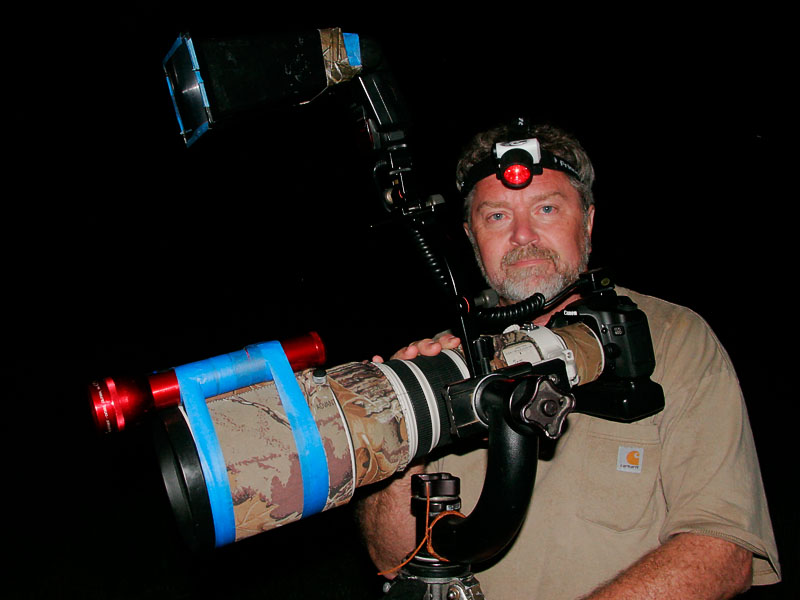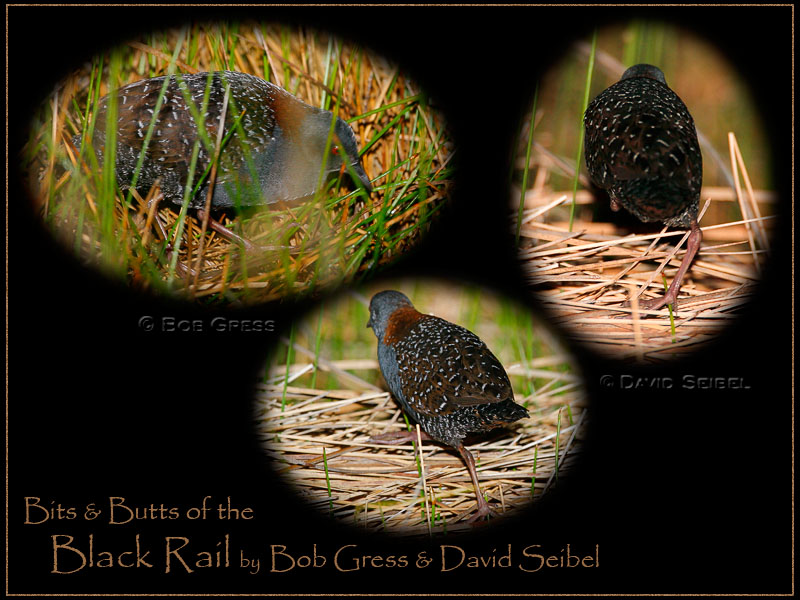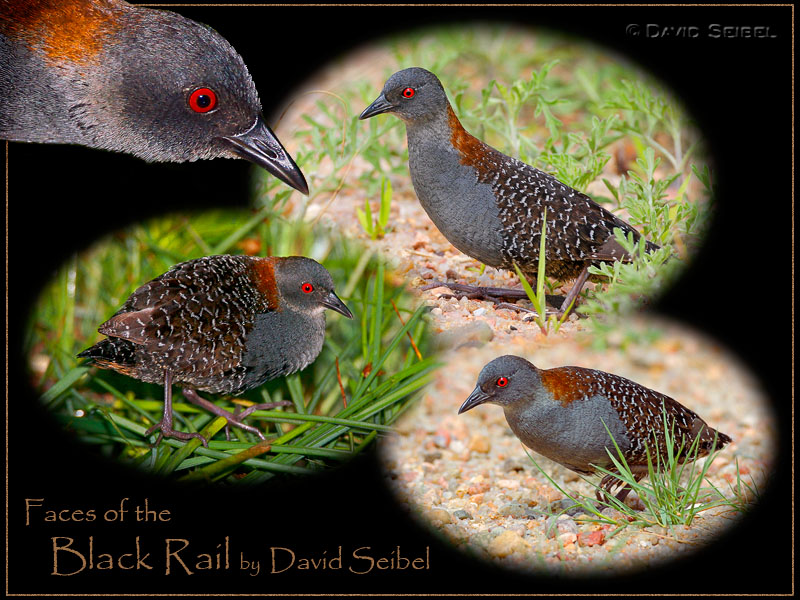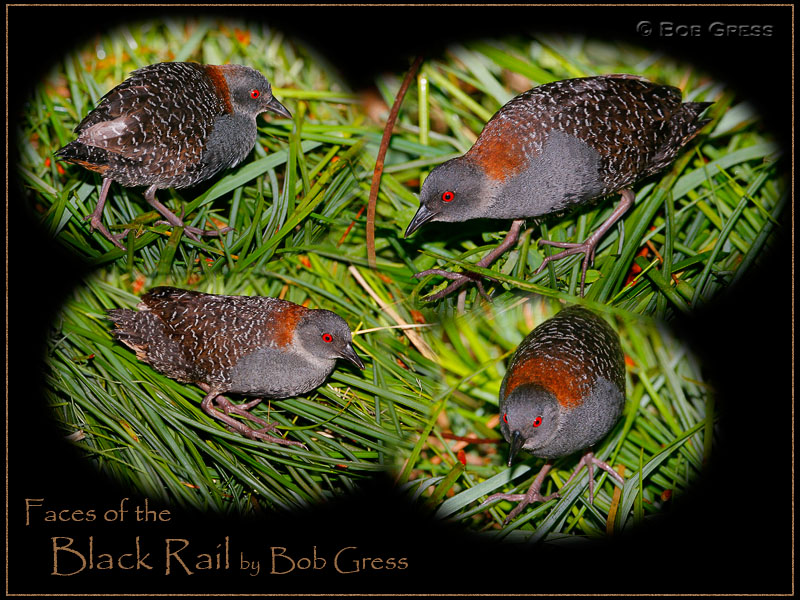|
Photographing the Black Rail
(A friendly competition between
good friends Bob Gress and David Seibel, told from Bob’s
perspective)
I’m not even sure anymore when the Black Rail
became my photographic nemesis. It entered my consciousness many
years ago when I became aware of their presence at Quivira
National Wildlife Refuge. I don’t even remember who identified the
strange call for me that was coming from the flooded meadow, but
as with nearly everyone, my early encounters were all “sounds
only.” Eventually, after many years of hearing the kee-kee-der
in the marsh, a glimpse of a tiny black form darting through the
cattails was my first official sighting. Over the next ten years I
may have accumulated a total of two seconds of observations from a
half dozen frustrating glimpses. During those early years I even
got the camera ready, just in case a bird might show itself to its
rival on the tape recorder. By today’s standards that hardly even
qualifies as a photo attempt.
In 1998 Suzanne Fellows, Mary Butel and I had one between us at
Coldwater City Lake, the only other area in Kansas with a known
population of Black Rails. We all pointed to the sound coming from
the cattails no more than six feet from any of us. Eventually I
saw the black blur and they both missed it. I didn’t have time to
even move the camera. About four years ago I decided that I would
get publishable photos and all I had to do was put in enough time
and find (1) the right combination of camera, lens and flash, at
the right settings, to photograph a sparrow-sized black bird at
night; (2) the right combination of area lights so I could see the
bird in the darkness; (3) the right spot for the bird to be so I
could find him in the thick vegetation; (4) a method of getting
the bird to go to that right spot; and (5) sufficient hormone
levels (the bird’s, not mine). For several years I experimented
with different set-ups and I amused the rails as they laughed
kee-kee-der. I tried mornings, I tried evenings, I tried
nights, they laughed kee-kee-der.
May 5, 2007. I tried again at Coldwater City Lake.
Not one rail could be coaxed into a response, even though I had
heard them the week before at Quivira. By 8:30 that night a nasty
northbound storm was bearing down on the lake, lightning was
popping, and I decided to retreat to a motel in town. Around 9:00
p.m. the whole town lost electricity and the storm passed directly
overhead. By 9:30 I was taking lightning pictures, from the motel
parking lot, of a fantastic light show just north of Coldwater and
bearing down on Greensburg. I'd never seen a storm like that one.
Tornado sirens sounded and every emergency vehicle in town headed
north out of Coldwater. By 11:30, and still with no electricity, I
went to bed. The next morning I drove north and discovered what
had happened the night before when the tornado leveled Greensburg.
I tried a few more times at Quivira in 2007, rails laughed
kee-kee-der and I found it more rewarding to go photograph
shorebirds. I read and reread William Burt’s accounts in Rare
and Elusive Birds of North America. He photographed one, why
couldn't I? David Seibel was also experimenting with photographing
this bird and was also failing to get photos, although he had
managed to see the birds more by daylight (before he had a good
camera, naturally) than I had. We realized that we had
inadvertently entered an informal race for the first good Black
Rail photos in Kansas. A little friendly competition is a healthy
thing, but we also recognized that the real contest was between
the rails and both of us, so we compared notes and plotted,
planned and studied for 2008. I had new ideas and plans, David had
his own strategies, and we combined our schemes. We agreed to work
together whenever possible, but the race was still on.
May 2, 2008. The Quivira wind howled and it was
cold! David and I had a Black Rail respond to a recording
mid-afternoon, and I saw two birds briefly flutter together about
a foot high before diving back into the sedges. That was a major
sighting! That evening, standing in the wind and the dark, with
rain mist in the air, we had none respond to the tape. We were
freezing and wet, and we quit by 11:30 p.m. Next time we’ll get
him!
May 3, 2008. It was perfectly calm with no moon,
and a Black Rail called as we got out of the truck around 10:30
p.m. He was close to the road. We set about preparing
our equipment. We had cameras with big lenses on tripods,
flashes on top of long flash brackets, and flashlights with red
cellophane taped to our lenses to assist focusing. We had lights
diffused with red cellophane for watching and red miner’s lights
on our foreheads for reading camera settings. We moved closer and
placed the remote speaker about fifteen feet out under a mat of
dried sedges. We stood ankle deep in the marsh water and played a
Black Rail call, and immediately a rail called back aggressively.
It sounded like it was under thick sedges about eight feet from
the speaker. Over the next hour we played the rail call, call off,
call on, call off; we waited quietly in the dark, rail came in,
rail calls got farther away, rail came in, rail retreated, rail
came closer; we looked and looked and never saw the bird. Not
enough hormones in the bird? We packed up and heard the rail
flutter off into the night. We could hear no other Black Rails in
the marsh. We went to bed about 12:30 a.m. Next time we’ll get
him!
May 8, 2008. David couldn’t join me, but I planned
to try for rails at Quivira after an evening presentation to the
Great Bend Camera Club. Rain and lightning forced me on home. I
was cruising in the dark at sixty mph when a lighting strike in
the fence line exploded with a fireball the size of my pickup. It
was no more than fifty feet away and I immediately put my hand to
the side of my face. It was sooooo hot! My ears were ringing; I
blinked back and forth from eye to eye until my eyes readjusted
after the flash. I didn’t even make it to the rail field, but it
was memorable. (Note from Seibel: This is what you get for trying
to beat me!)
May 17, 2008. David and I met again at Quivira. We
put on rubber boots and headed into the sedges at 9:30 p.m. Under
a full moon, we sloshed through the boot-sucking mud towards a
rail calling in the distance. It sounded like he was close.
Perhaps 400 yards later we finally got to the bird. We set up and
turned on the calls, and eventually a bird came to the speaker! We
should have been more careful preparing the platform. We each got
two photos of the bird behind distracting sedges. Another bird
called farther out. We sloshed on, did a better job preparing the
platform with a mat of dried sedges and started the rail calls.
About ten minutes later we saw movement and turned on the focusing
lights, and the bird tore across the platform to vanish
permanently into the sedges behind it. We each got a single butt
shot! All told, we heard at least eight birds calling at different
times that night. Perhaps their hormones were taking over, but
they still weren’t aggressive or curious enough to allow a good
shot. As Seibel put it, we had curious, we needed furious. We got
out of the marsh at 3:00 a.m., and after six hours of
mosquito-buzzing/ biting/ swatting, standing in stinky swamp water
with eyes straining in the darkness... we each had
three bad Black Rail images. We averaged one bad photo for
every two hours of work. We were thrilled; it was the most
successful Black Rail photography night we’d ever had! We
collapsed on sleeping bags at 3:30 a.m. and were back up
photographing shorebirds with early light at 7:00 a.m. We were so
close to getting the shot. Next time we’ll get him for sure!
May 30, 2008. David and I met on
the Wildlife Drive around 6:00 p.m. We felt lucky! We planned to
photograph birds while we had good light and then meet over at the
rail field. Shorebird migration was definitely winding down. Not
nearly the numbers we’d seen earlier in the month, but still
plenty of subjects to photograph. While the bird numbers had
dropped, the mosquito numbers had certainly increased! We met at
dusk, and as I stepped out of my truck I immediately felt
mosquitoes on my bare legs. I brushed both legs and killed at
least a dozen in the first ten seconds. Was this an omen? I
quickly put on some jeans and slathered up with DEET. It would be
a very dark, calm night. Just a sliver of a moon would be out much
later. We heard a Black Rail in the distance, but he was a long
way out in the marsh. We were getting better at preparing our
equipment, but it still took nearly a half hour to get everything
ready. I also harvested a six-inch bundle of fresh cut sedges that
we would use to hide the speaker. We were full of optimism and
eager to get started, but no rails were calling. We strained to
hear through the constant drone of mosquitoes. Then the rail on
the far side of the sedge meadow called again. Darn, we were
hoping for one close to the road.
We sloshed into the sedges, which had grown significantly since we
were here two weeks ago. It is hard to describe the feeling of
trudging through this sedge meadow at night without using a
flashlight. In the darkness it is impossible to see where you are
stepping or what lies ahead. The growing plants were only about
two feet tall, but they were emerging through dried waves of
sedges accumulated from last year’s growing season. If the mat was
flat on the ground, walking was easy, but this was rarely the
case. Much of the time the mat was suspended in this year’s
growing crop about a foot above the ground. Every step plunged
back through this mat of vegetation, into about three inches of
water and then into the mud. With every step we stirred up a new
cloud of mosquitoes that joined our hovering halo held at bay by
the magic of DEET. It was very dark, and it was fun to see the
many stars always hidden in our urban skies, although we figured
the stars tonight were outnumbered by the mosquitoes.
By the time we made it across the meadow the rail had quit
calling. We stood in the darkness listening. We tried playing our
rail calls, but no bird responded. Why were they so quiet tonight?
Where were they? Finally a different bird called. It sounded to be
several hundred yards to the east. Off we sloshed. When we got
close it quit calling, and it also ignored our calls. After a
couple of hours of this our optimism was dwindling. Another bird
called back by the road, not far from where we had started. Off we
sloshed. When it also went silent we made our way back to the
road, almost ready to concede another night to the rails. At least
we could walk again in relative comfort.
Then another rail called, and it was close! He was calling from
the ditch no more than ten feet from the edge of the road. We set
the speaker under our portable mat of sedges and played a call. He
called back. That was good. Then he got quiet. That was better. He
was approaching. We saw movement at the edge of the sedges.
Shutters and flashes popped. He crossed the mat searching for his
new neighbor. More shutters and flashes. He doubled back across
the mat and was gone. According to the time recorded on the photos
his visit lasted about 9 seconds. We could not convince him to
make another appearance, although he remained nearby and kept
calling incessantly.
It was now nearly midnight. Across the marsh we could hear a
couple more rails. Off we went. They got quiet. Back we came. We
were getting tired and must have been walking with our mouths
open. I heard David coughing and sputtering behind me, and then I
also inhaled a mosquito and managed to get it back out. We inhaled
and spit our way across the marsh, stopping long enough to discuss
the calories in the half dozen we had ingested. By the end of the
night, we had mosquitoes in places we didn’t know they could go.
David discovered one smashed between his left eye and his glasses,
and at least one that he inhaled went into his nostril, not his
mouth. Neither of us was complaining; we were both happy to have
gotten a decent shot of a Black Rail, though there was still
certainly room for improvement.
Our roadside friend was still calling when we returned at 2:30
a.m. Would he respond again if we set up on the marsh side of the
ditch? Maybe he would think it was a different neighbor. We set
up. He talked to our recording. Then quiet. Great, he was moving.
Like a mouse he suddenly emerged onto the mat. Cameras and flashes
popped. He disappeared back into the darkness and the protection
of the sedges. We shut off the calls. We would let him think he
had chased away his new neighbor. After ten minutes we tried again
and he made an encore appearance. This time he stopped and stood
frozen for a full twenty seconds, staring in the direction of the
speaker. I’d never seen a Black Rail that wasn’t moving! Cameras
flashed and flashed and flashed. He turned, came toward us, and
then disappeared into the darkness. We spent nearly seven hours in
the marsh and had managed almost forty seconds of viewing/
photography time. Standing in the darkness, high-fives seemed
appropriate. We packed up and welcomed sleep at 4:00 a.m.
For years, a major goal for both of us was to get good photographs
of a Black Rail. Now that we have
the photos we realize that as with any adventure, the real
reward and the real memories lie with the journey.
Addendum from David Seibel
One of my favorite sounds is Bob’s crooning “Ooooh, baby!” when he
looks at the preview of a winning shot. There were a few of those
that night, right there in the sedge meadow, and I remember
thinking as I tripped my shutter for the last time, “THAT’S the
shot I wanted!” We had both won the “race,” and better yet, we had
tied. Bob had to leave early the next morning, but I stayed to see
what else I could find to photograph. After an uneventful pass of
the Wildlife Drive, I stopped by the rail meadow once more around
10:30 a.m. A Black Rail was calling beside the road in the same
spot as the night before – probably our one cooperative bird,
which I’m guessing might be an unmated male. I had recorded some
of his calls the previous night and decided to see what effect
they might have on him in daylight. No elaborate preparations, no
slogging for miles in the dark through the sedge-infested mosquito
swarm; just setting the speaker on the side of the road and
playing a few calls. Suffice it to say that I broke in my new
camera (which I’d prudently chosen not to try for the night shots)
on a very cooperative Black Rail. Alas, the challenge and mystery
of the images might somehow seem diminished by a gravel road or my
car as the background, but
I captured them anyway. This, of course, enticed me to stay
and try for one more series of “easy” night shots, for which I was
rewarded with about a million mosquito bites and much more typical
behavior (lots of calling and not a single appearance) by the
Black Rail. Had he found a mate? Had he realized the hoax of those
ultra-sexy calls? Had he become habituated to the idea of a new
neighbor? Who knows, but in a way I’m glad… the challenge and
mystery survive!

Bob's equipment setup. David's setup was nearly identical except
for the camera body.

Examples of best attempts by Bob (left and center) and David
(right), May 17-18, 2008.

Collage of some of David's better
photos, May 31, 2008. Inset and lower left, Canon EOS 1D Mark II N
+ EF 500mm f/4L IS with 1.4x teleconverter, full flash
illumination; upper and lower right, Canon EOS 40D + EF 500mm f/4L
IS, no flash or fill flash only.

Collage of some of Bob's better
photos, May 30-31, 2008. Canon EOS 40D + EF 500mm f/4L IS, full
flash illumination.

"Why does the Black Rail cross the road?" In this case, we really
don't know why or even how often it happens, but don't expect to
see any "Black Rail Crossing" signs anytime soon. This bird
apparently stayed on the south side of the road all day after it
made its bold daylight dash from the north, and it did not seem to
know quite what to make of Seibel's car. Composite (original size,
10800 x 2734 pixels) of seven images taken May 31, 2008, 11:07:24
- 11:07:33 a.m.; an eighth (not included) shows the bird
underneath the vehicle. Canon EOS 40D + EF 500mm f/4L IS, no flash
or fill flash only. Click here for a larger version. |